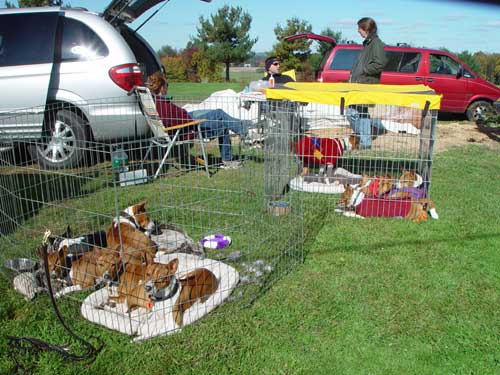
The Rip Van Wrinkler
The quarterly newsletter for the Rip Van Wrinkle Basenji Club.
Rip Van Wrinkler Editors:
Editor in Chief - Susan Kamen Marsicano
Peon Editors in Chief:
Roy Schecter
Tamara E. Allen
Copy Editor - Karen Sahulka
The Wrinkler is published at our club website - rvwbasenjiclub.org.
Past issues that were online, are also on the club site.
Below is some older stuff which is still interesting.
*The Wrinkler is published quarterly: February, May, August & November.
Deadline for receiving material for publication is the 1st day of the previous month.
The contents of The Rip Van Wrinkler do not necessarily represent the opinions of
the editors, or the membership. All rights to reproduce any part of The Rip Van Wrinkler®
shall be done with the permission of the editors.
The Rip Van Wrinkle Basenji Club is affiliated to the Basenji Club of America.
The Inside Story Of "Goodbye My Lady"
by Veronica Tudor -Williams / April 1973 ~The Basenji
Mercury (and other things) in vaccines by Karen P. Christensen

Lately the issue of a mercury-containing preservative, thimerosal, in human vaccines routinely given to babies and young children has made headlines in publications as diverse as the Wall Street Journal and Rolling Stone Magazine. Mercury can interfere with brain and nerve development and affect both motor skills and behavior. In addition, there is evidence that mercury in the mother's tissues during pregnancy can affect neuro-logical development, so mothers are cautioned to minimize the exposure of the fetus. And what can happen in humans may happen to our dogs, too, if they are exposed. Exposure to mercury is much less common in dogs than in humans because they don't normally eat fish that would have a high concentration of the contaminant; however, there may be thimerosal in their vaccines. Thimerosal is less hazardous than the forms of mercury that occur in the environment, since it stays in the body a shorter time, but it is a risk that can be avoided altogether.
Preservatives have been used in vaccines for decades. Vaccines are often provided in multiple-dose containers and the repeated puncturing of the seal, even with sterile needles, can result in contamination with pathogenic bacteria that if injected along with the vaccine can result in serious infection or death. Even single-dose vaccines, produced in a clean factory, carry the risk of contamination with harmful bacteria. Plus, vaccines are grown in tissue cell cultures that are easily contaminated with bacteria that interfere with the growth of the vaccine, so antibiotic preservatives are added during culturing. The antibiotic (usually gentamicin) is then included in the final vaccine. Concerns have been raised in recent years regarding overuse of antibiotics, due to the development of strains of bacteria that are resistant to all but the harshest antibiotics and fear of the genesis of Superbugs.
You might also have heard that too much vaccination is also a bad thing. For the past several decades the recommendation to vaccinate yearly against a wide variety of contagious diseases in dogs (distemper, parvo, hepatitis, influenza, corona), and which dogs may pass to people (leptospirosis, rabies) was based on the fact that a year was the duration of immunity which had been demonstrated clinically in challenge tests. A challenge test is when immunized animals are exposed to live virus to see if they get sick. But there has long been evidence based on titer tests (measuring the level of immune response products in the blood) that immunity lasts longer than a year, maybe many years, and suspicion that yearly revaccination wreaks havoc on the dog's immune system without providing any benefit. In cats, it has been demon-strated that annual vaccination increases the incidence of specific types of cancer.
 Alibeany & Badia
Alibeany & Badia
So, what to do?
It's dangerous to your dog not to vaccinate against contagious and deadly diseases such as rabies, distemper, and parvo. Yet it is potentially dangerous to give them the vaccines because they may contain other harmful ingredients. And clearly, it is not beneficial from either standpoint to vaccinate yearly, exposing your dog to both immune stimulation and preservatives that are both potentially harmful. Here is an approach that balances and minimizes the risks:
1. Have your puppy vaccinated with mercury-free vaccines. There are lists available on the Internet of dog vaccines which do and do not contain thimerosal (e.g., see www.los-suenosaussies.com) -- but remember the data in them may be inaccurate or out of date, and contact the maker of the vaccine if needed to make sure. If you take your pet to a rabies clinic (as is offered by many towns) it is likely the vaccine is provided from a multiple-dose container, and may contain thimerosal.
2. Know what your veterinarian is giving your dog, and insist on mercury-free vaccines. Most vaccines are available to individuals and may be bought in single doses that you can take with you to the vet. The exception in most states is rabies -- but talking to the office staff in advance should allow you to know if the vaccine your vet uses contains mercury, and take action to request a single-dose rabies vaccine without mercury. Be prepared to provide the office with all the supporting information, and to walk out if the vet doesn't cooperate. If your vet doesn't respect your desire to protect your pet, you have to wonder what he's practicing for!
3. Recognize that gentamicin or other antibiotic preservative does not present the risk of developing antibiotic resistance. The small amount of gentamicin, at the subcutaneous or intramuscular injection site, does not result in a therapeutic (antibiotic) concentration in the bloodstream and thus doesn't exert the selective effect that is key to developing antibiotic resistance.
4. Use only the core vaccines (rabies, distemper, parvo) plus those that prevent infection with pathogens that are of specific concern given your location and your dog's lifestyle. City dogs should definitely receive the hepatitis (Adenovirus Type II) vaccine, and dogs who are kennelled frequently or who live in a kennel should have Bordetella (kennel cough) vaccine. A series of parvo and distemper shots is recommended for puppies to ensure the vaccine stimulates the immune system after the immunity from the mother wears off some time between 10 and 16 weeks of age. Rabies vaccine should not be given at the same time as parvo and distemper -- they should be separated by at least 2 weeks. It is still recommended that all three vaccines be repeated (again, separated by at least 2 weeks) approximately 1 year later.
5. Decrease the frequency of revaccination as much as possible. Whenever possible, titer test instead of vaccinating, and defer revaccination for as long as the tests show immunity.
6. Rabies vaccines have now been shown in challenge tests to be effective for at least three years, although they are required at yearly intervals in some states (note, the same vaccine is usually given whether at one or three-year intervals). Most recently, Intervet has conducted challenge tests demonstrating the effectiveness of their parvo and distemper vaccine after three years, thus providing a three-year vaccine (Continuum) so it is not necessary to titer for the first three years after giving it. It contains gentamicin, but not thimerosal.
7. If your dog has ever had an allergic response to a vaccine, don't revaccinate with it! You have to weigh the risks, but in an allergic dog generally the chances of your dog getting sick with rabies, distemper or parvo after it has been vaccinated even once in its life is low compared to the risk of a life-threatening allergic reaction if you repeat the insult. Veterinarians are in the position to issue waivers from vaccination when allergic reactions have been documented. DON'T use Benadryl or other antihistamines to pre-treat an allergic dog so it can receive a vaccination it probably doesn't need anyway.
8. Likewise, don't vaccinate a sick dog. Only healthy dogs should be vaccinated -- if your dog is sick or stressed its immune system is busy dealing with the sickness or stress. Piling a vaccine on that decreases the effectiveness of the dog's immune system at fighting the illness, inhibits the development of an effective immune response to the vaccine, and increases the probability of an allergic reaction.
Know Your Dog, Know Your Dog’s Health Tests
by Natalie Culver
I have been treating Kunjo’s slightly low thyroid for a few years now. I have run into a second difficulty in obtaining the veterinary care I wanted. The first was a vet's miss labeling of a generic thyroid medication for the name brand (Pg. 16 of the November 2001 Wrinkler). My recent, second, difficulty was not receiving the tests I had requested, and therefore receiving incorrect results (not from the same veterinary practice).
The recent wrong tests could have been prevented had I been more persistent on having the blood sent to Dr. Dodd’s Hemopet. The veterinarian was concerned about the blood shipment getting to Hemopet in California all the way from my home in Connecticut in a timely fashion. My vet's office did not want to ship the blood themselves, and I could not pick up the blood until the next morning, so the centrifuged blood would have to sit overnight at my veterinarian's office. In hindsight I should have requested they centrifuged the blood right after the blood was drawn and I would have waited at the office until I had it in my hand!
My vet told me that they could have ship Kunjo's blood sample out to their own lab and run the exact same tests that I was going to have Hemopet run. The vet convinced me that this would be better, the blood would still sit overnight in CT until analysis at a local lab, but I thought this would be better then the sample potentially not getting to Hemopet until the weekend and sitting out until Monday morning (another mistake, Hemopet would probably have had someone present to collect sample shipments on the weekend.)
I explained to my vet that I would need to have the 6-panel thyroid test run that Dr. Dodds uses, and I would still want the test results sent to Dr. Dodds for her interpretation. My veterinarian assured me that his lab would run the same tests and in fact it was the same laboratory company that Dr. Dodds had used, Antech Diagnostics. (Antech Diagnostics has laboratories throughout the country, but as I learned they don’t all perform the same tests!) All of these things talked me into paying my vet, an $80 fee, to have him send the blood to his lab.
My vet called with the test results and said Kunjo's levels were "fine," and his dosage of Soloxine, correct. It was suggested I ask for a copy of those results.
Two days later the results were faxed to me, and .... (drum roll please) .... the 6-panel thyroid screen I was promised had not been run. I paid for testing that I did not want, the test I did want were not run, and my husband and I had both taken time off from work to get Kunjo dosed and to the vet's office at the correct time interval (4 to 6 hours post pill). I spent some time on the phone with my vet and the laboratory that day to determine if the blood was still at the lab, and if it was, I wanted to know if the lab could run the correct 6-panel screen. Not only was the blood no longer available for testing, but the local Antech Diagnostics lab did not even have the capability to perform the 6-panel thyroid screen. My veterinarian did apologize and let me bring Kunjo in for a second blood draw at no charge, though I was not offered a refund for the wrong testing I had already paid.
If you have not tested your dogs thyroid you should, and Dr. Dodd's Hemopet is the place to have the testing and interpreting done. Take it from my experience; you are better off sending the sample to Hemopet. If your veterinarian will not accommodate your request to send out the testing I'm sure you could find another local vets office who would be more than happy. Remember you will still need to pay your local vet's customary blood draw fees.
Over the last year I had noticed a slow down in Kunjo’s normal high energy level. I attributed this to Kunjo finally growing up; he turned four in Dec. 2003. Now I think that this slight change in his behavior was due to an inadequate amount of thyroid supplementation. Certainly the fact that he was neutered in the last year made retesting even more important.
 photo by Jens Ratsey
photo by Jens Ratsey
Since I received the results from Dr. Dodds that Kunjo's thyroid was low I have increased his medication as directed.
Kunjo is more energetic, playful, and generally back to his mischievous self.
Now Kunjo is back to enjoying lure coursing, as a fair weather courser :-)
Kunjo is a Basenji Club of America "Versatile Basenji" - Apu Jay Dreamin' Breeze RN NAJ SC SGRC2 JOR CGC VB.
This is who you want to run tests for your dog!
W. Jean Dodds DVM ~ Hemopet, 11330 Markon Drive Garden Grove, CA 92614
tel 714-891-2022, fax 714-891-2123
Stuff, Stuff, Stuff......
Posters
The Bakers' Dozen - $30
‘Kiafrika Azima’ - $20
Kiafrika Azima 2, Kidz 'n Da Hood - $20
Twin Towers Tight Rope - $30
All Signed, limited editions of 200.
ALL PROCEEDS to: the Basenji Health Endowment & The American Cancer Society in celebration of our cancer survivors.
Melissa Langston Sanford
*Wilderness Expressions," Silver & gold charms, etc.
Gone Doggin – Susan Osher:
The Basenji Coverlet
H.R. Hoerr / LTD Leathergoods
Leather Lure Coursing Slip Leashes & Obedience Leashes
Richard Gallione
Custom Leather work. "Master's Pride."
William & Shirley Wagner
"WiSh Crafts" - Basenji sun catchers, stained glass panels,
Special orders from your own photos. (508) 543-6651
CATALOGS:
Omaha Vaccine - (800) 367-4444
KV Vet - (800) 423-821